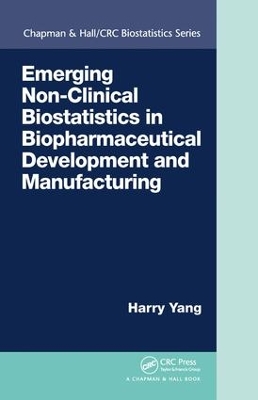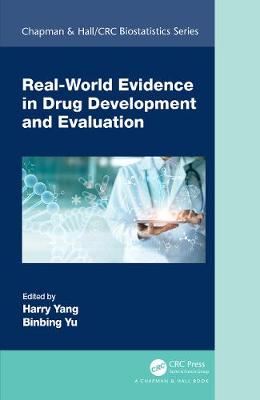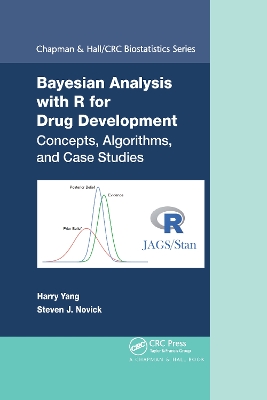Chapman & Hall/CRC Biostatistics
5 total works
Emerging Non-Clinical Biostatistics in Biopharmaceutical Development and Manufacturing
by Harry Yang
The premise of Quality by Design (QbD) is that the quality of the pharmaceutical product should be based upon a thorough understanding of both the product and the manufacturing process. This state-of-the-art book provides a single source of information on emerging statistical approaches to QbD and risk-based pharmaceutical development. A comprehensive resource, it combines in-depth explanations of advanced statistical methods with real-life case studies that illustrate practical applications of these methods in QbD implementation.
Statistical Methods for Immunogenicity Assessment
by Harry Yang, Jianchun Zhang, Binbing Yu, and Wei Zhao
Develop Effective Immunogenicity Risk Mitigation Strategies
Immunogenicity assessment is a prerequisite for the successful development of biopharmaceuticals, including safety and efficacy evaluation. Using advanced statistical methods in the study design and analysis stages is therefore essential to immunogenicity risk assessment and mitigation strategies. Statistical Methods for Immunogenicity Assessment provides a single source of information on statistical concepts, principles, methods, and strategies for detection, quantification, assessment, and control of immunogenicity.
The book first gives an overview of the impact of immunogenicity on biopharmaceutical development, regulatory requirements, and statistical methods and strategies used for immunogenicity detection, quantification, and risk assessment and mitigation. It then covers anti-drug antibody (ADA) assay development, optimization, validation, and transfer as well as the analysis of cut point, a key assay performance parameter in ADA assay development and validation. The authors illustrate how to apply statistical modeling approaches to establish associations between ADA and clinical outcomes, predict immunogenicity risk, and develop risk mitigation strategies. They also present various strategies for immunogenicity risk control. The book concludes with an explanation of the computer codes and algorithms of the statistical methods.
A critical issue in the development of biologics, immunogenicity can cause early termination or limited use of the products if not managed well. This book shows how to use robust statistical methods for detecting, quantifying, assessing, and mitigating immunogenicity risk. It is an invaluable resource for anyone involved in immunogenicity risk assessment and control in both non-clinical and clinical biopharmaceutical development.
Real-World Evidence in Drug Development and Evaluation
by Harry Yang and Binbing Yu
Real-world evidence (RWE) has been at the forefront of pharmaceutical innovations. It plays an important role in transforming drug development from a process aimed at meeting regulatory expectations to an operating model that leverages data from disparate sources to aid business, regulatory, and healthcare decision making. Despite its many benefits, there is no single book systematically covering the latest development in the field.
Written specifically for pharmaceutical practitioners, Real-World Evidence in Drug Development and Evaluation, presents a wide range of RWE applications throughout the lifecycle of drug product development. With contributions from experienced researchers in the pharmaceutical industry, the book discusses at length RWE opportunities, challenges, and solutions.
Features
- Provides the first book and a single source of information on RWE in drug development
- Covers a broad array of topics on outcomes- and value-based RWE assessments
- Demonstrates proper Bayesian application and causal inference for real-world data (RWD)
- Presents real-world use cases to illustrate the use of advanced analytics and statistical methods to generate insights
- Offers a balanced discussion of practical RWE issues at hand and technical solutions suitable for practitioners with limited data science expertise
Bayesian Analysis with R for Drug Development
by Harry Yang and Steven J. Novick
Drug development is an iterative process. The recent publications of regulatory guidelines further entail a lifecycle approach. Blending data from disparate sources, the Bayesian approach provides a flexible framework for drug development. Despite its advantages, the uptake of Bayesian methodologies is lagging behind in the field of pharmaceutical development.
Written specifically for pharmaceutical practitioners, Bayesian Analysis with R for Drug Development: Concepts, Algorithms, and Case Studies, describes a wide range of Bayesian applications to problems throughout pre-clinical, clinical, and Chemistry, Manufacturing, and Control (CMC) development. Authored by two seasoned statisticians in the pharmaceutical industry, the book provides detailed Bayesian solutions to a broad array of pharmaceutical problems.
Features
- Provides a single source of information on Bayesian statistics for drug development
- Covers a wide spectrum of pre-clinical, clinical, and CMC topics
- Demonstrates proper Bayesian applications using real-life examples
- Includes easy-to-follow R code with Bayesian Markov Chain Monte Carlo performed in both JAGS and Stan Bayesian software platforms
- Offers sufficient background for each problem and detailed description of solutions suitable for practitioners with limited Bayesian knowledge
Harry Yang, Ph.D., is Senior Director and Head of Statistical Sciences at AstraZeneca. He has 24 years of experience across all aspects of drug research and development and extensive global regulatory experiences. He has published 6 statistical books, 15 book chapters, and over 90 peer-reviewed papers on diverse scientific and statistical subjects, including 15 joint statistical works with Dr. Novick. He is a frequent invited speaker at national and international conferences. He also developed statistical courses and conducted training at the FDA and USP as well as Peking University.
Steven Novick, Ph.D., is Director of Statistical Sciences at AstraZeneca. He has extensively contributed statistical methods to the biopharmaceutical literature. Novick is a skilled Bayesian computer programmer and is frequently invited to speak at conferences, having developed and taught courses in several areas, including drug-combination analysis and Bayesian methods in clinical areas. Novick served on IPAC-RS and has chaired several national statistical conferences.
Cure Models: Methods, Applications and Implementation is the first book in the last 25 years that provides a comprehensive and systematic introduction to the basics of modern cure models, including estimation, inference, and software. This book is useful for statistical researchers and graduate students, and practitioners in other disciplines to have a thorough review of modern cure model methodology and to seek appropriate cure models in applications. The prerequisites of this book include some basic knowledge of statistical modeling, survival models, and R and SAS for data analysis.
The book features real-world examples from clinical trials and population-based studies and a detailed introduction to R packages, SAS macros, and WinBUGS programs to fit some cure models. The main topics covered include
- the foundation of statistical estimation and inference of cure models for independent and right-censored survival data,
- cure modeling for multivariate, recurrent-event, and competing-risks survival data, and joint modeling with longitudinal data,
- statistical testing for the existence and difference of cure rates and sufficient follow-up,
- new developments in Bayesian cure models,
- applications of cure models in public health research and clinical trials.




